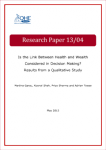Sign up to our newsletter Subscribe
Challenges and Solutions for Budget Impact Analysis of Gene Therapies

Sign up to our newsletter Subscribe

Traditionally, decision makers both within and outside the health sector have thought of the value of health interventions primarily in terms of reduced morbidity or mortality. Health care, however, produces wealth effects outside the health care sector—for example, improvement in…

Traditionally, decision makers both within and outside the health sector have thought of the value of health interventions primarily in terms of reduced morbidity or mortality. Health care, however, produces wealth effects outside the health care sector—for example, improvement in labour productivity for both patients and caregivers, cost savings in health and social care and other sectors, and an increase in national income.

Traditionally, decision makers both within and outside the health sector have thought of the value of health interventions primarily in terms of reduced morbidity or mortality. Health care, however, produces wealth effects outside the health care sector—for example, improvement in labour productivity for both patients and caregivers, cost savings in health and social care and other sectors, and an increase in national income. These wealth effects are considered infrequently, at best, in government decisions outside health agencies.
The extent to which these wealth effects have had an impact on the advice given by health technology assessment (HTA) bodies or on budget setting in other government departments has not been explored fully. With that in mind, this research was intended to examine whether the wealth effects of one type of health care—prescription medicine interventions—are considered in resource allocations and, if not, why not.
To gather information, we targeted decision makers in three types of government agencies—finance, health, and HTA—in eight countries: Australia, France, Germany, Italy, Poland, South Korea, Sweden and the UK. We found that only in Sweden does decision making take into account that the investment in health care, including medicines interventions, can improve economic output. Barriers to a broader perspective included system fragmentation that precludes taking advantage of spillovers across sectors, methodological issues in HTA, and a short-term focus by governments exacerbated by the effects of the economic recession. The paper concludes with a discussion how to address the barriers identified in order to ensure efficient priority setting within health and across public sectors.
Download: Garau, M., Shah, K., Sharma, P. and Towse, A. (2013) Is the link between health and wealth considered in decision makikng? Results from a qualitative study. Research Paper 04/13. London: Office of Health Economics.
An error has occurred, please try again later.
This website uses cookies so that we can provide you with the best user experience possible. Cookie information is stored in your browser and performs functions such as recognising you when you return to our website and helping our team to understand which sections of the website you find most interesting and useful.
Strictly Necessary Cookie should be enabled at all times so that we can save your preferences for cookie settings.
If you disable this cookie, we will not be able to save your preferences. This means that every time you visit this website you will need to enable or disable cookies again.
This website uses Google Analytics to collect anonymous information such as the number of visitors to the site, and the most popular pages.
Keeping this cookie enabled helps us to improve our website.
Please enable Strictly Necessary Cookies first so that we can save your preferences!